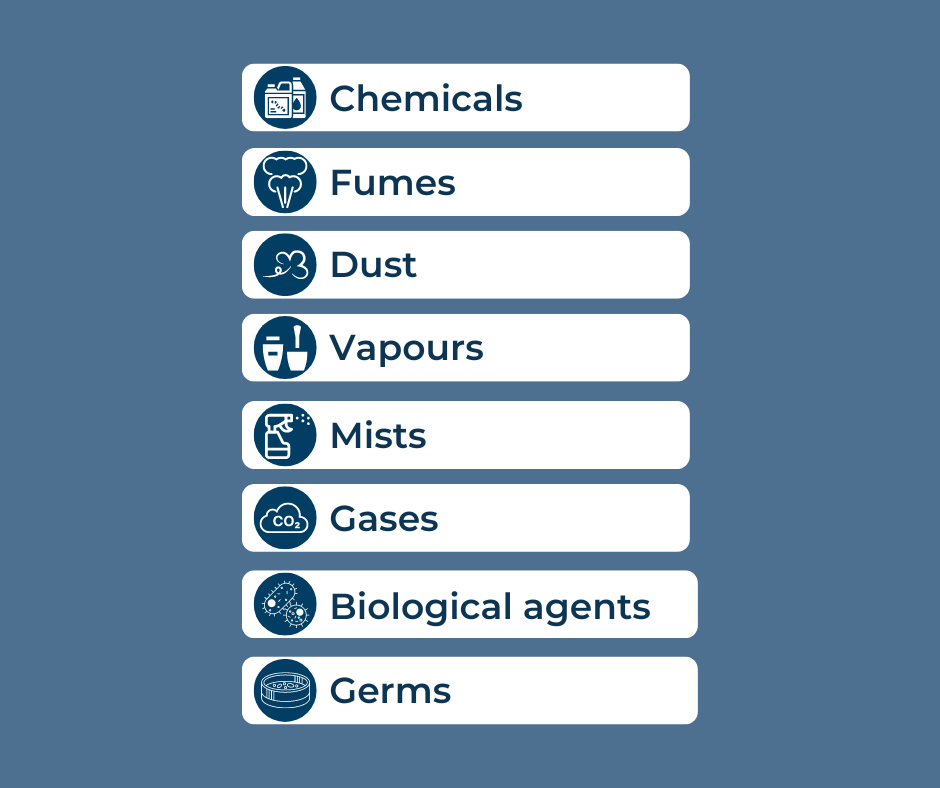As part of February’s Hazard of the Month, COSHH, we’re highlighting two key areas: Control of Hazardous Substances and Legionella.
Control of Hazardous Substances
 Employers have a legal responsibility to safeguard workers from exposure to hazardous substances, including:
Employers have a legal responsibility to safeguard workers from exposure to hazardous substances, including:
- Dust
- Fumes
- Chemicals
- Vapours
- Mists
- Nanotechnology
- Gases
- Biological agents
- Germs
For substances classified as carcinogens, mutagens, or asthmagens, exposure must be minimised as much as reasonably practicable, following the Control of Substances Hazardous to Health Regulations 2002 (COSHH).
What is exposure?
Exposure occurs when a substance enters the body through:
- Skin contact
- Ingestion
- Injection
- Inhalation of dust, gas, fumes, or mist
The Health and Safety Executive (HSE) establishes Workplace Exposure Limits (WELs), which are approved occupational exposure thresholds designed to protect workers’ health. WELs define the maximum concentration of hazardous substances in the air, averaged over a specific period.
Exposure levels can be assessed through monitoring—measuring the concentration of a substance in the air a worker breathes while performing a task. This process helps evaluate whether existing control measures are effective; if exposure remains below the WEL, the measures are likely working.
Ensure you understand COSHH regulations with our Control of Hazardous Substances Online Training. Get 10% off this course with the code ‘coshh10′!
Legionella
 Legionellosis refers to a group of illnesses caused by Legionella bacteria, including Legionnaires’ disease, Pontiac fever, and Lochgoilhead fever. Legionnaires’ disease is a potentially fatal form of pneumonia that can affect anyone.
Legionellosis refers to a group of illnesses caused by Legionella bacteria, including Legionnaires’ disease, Pontiac fever, and Lochgoilhead fever. Legionnaires’ disease is a potentially fatal form of pneumonia that can affect anyone.
Certain individuals are at higher risk, including those over 45, smokers, heavy drinkers, and individuals with chronic respiratory conditions, kidney disease, lung disease, heart disease, diabetes, or weakened immune systems.
Outbreaks occur when airborne water droplets containing Legionella bacteria are inhaled. These droplets typically originate from systems such as evaporative condensers, spa pools, and hot and cold water systems, where water is kept at temperatures that promote bacterial growth.
Factors that increase the risk of legionella:
- Water temperatures between 20-45°C in parts or all of the system
- The creation and dispersal of breathable water droplets, such as those from cooling towers or water outlets
- Stored and/or recirculated water
- The presence of deposits that support bacterial growth, such as rust, sludge, scale, organic matter, or biofilms
Responsibilities for employers and premises managers
If you are an employer or responsible for a premises, you have a legal duty to understand and manage Legionella risks. Any system capable of producing Legionella must undergo a risk assessment, with control measures tailored to the level of risk. These assessments must be reviewed regularly, even if no immediate action is needed initially.
You must ensure you can:
- Identify and assess sources of risk
- Manage and mitigate risks
- Prevent or control exposure
- Maintain accurate records
- Fulfil any other related responsibilities
Protect your organisation from legionella with our Legionella E-Learning course. Get 10% off this course with the code ‘coshh10’!

Control of Hazardous Substances and Legionella are essential tools staying safe around substances hazardous to health. Make sure you don’t miss out on our 10% off deal on these essential courses, available until the end of February. Simply enter the code ‘coshh10’ at checkout to save!
Read more Safety Spotlight blogs here
To keep up to date with the latest health & safety news and advice, follow us on social media:
